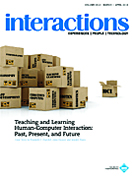Authors:
Dekita Moon
How do you describe your lab to visitors?
The Human-Centered Computing Lab (HCCL) is focused on designing, building, and evaluating computational technologies as they relate to the human condition and reflecting on how these technologies affect society. Addressing national social matters within the School of Computing enables us to work with various departments, such as English, psychology, business, engineering, sociology, history, and athletics. We also collaborate beyond the university's borders, working with state- and federal-government offices and organizations such as BMW, the Center for Minorities and People with Disabilities in Information Technology (CMD-IT), among many others.
The HCCL was founded in the fall of 2000 at Auburn University by Juan Gilbert, currently Presidential Endowed Chair and chair of the Human-Centered Computing Division at Clemson University in the School of Computing. The HCCL has received funding from the U.S. Election Assistance Commission (EAC), the National Science Foundation (NSF), and private industry. Our research covers a variety of areas, including electronic voting, automotive user interfaces, advanced learning technologies, culturally relevant computing or ethnocomputing, and databases and data analytics. The goal is to build innovative solutions to real-world problems by integrating people, information, culture, policy, and technology to address societal issues.
What is a unique feature of your lab?
In our lab, we all share the common objective to change the world. This goal has brought together a diverse group of people who collaborate within a fun and energetic work environment. A wall covered with more than 20 different undergrad pennants expresses our various academic and cultural backgrounds. Each pennant represents one or more students who contributed to the HCCL. This feature reminds us that our strength is within our differences, which we devote to the objectives of the lab.
How many people are in the lab, and what is the mix of backgrounds and roles?
Our lab consists of four undergraduates and 21 graduate students coming from more than seven fields of study. We collaborate in separate teams but function as one unit. Every student works on three projects: as a leader on a project, a team member on another, and of course, as lead on her or his own research. We all choose to apply ourselves and engage in projects that are of interest to us and have societal impact.
How would you briefly describe a day in the life of your lab?
Typically, most students enter the lab between 10 and 11 a.m., though several lab members can be found shortly after sunrise. At this time, constructive and empirical research is initiated. As the afternoon approaches, you will find interaction among groups on existing projects and classes. Group meetings may take place at any time of day in the lab. Juan Gilbert generally visits throughout the day to provide us with updates. For the rest of the time, students occupy themselves with more research and coursework. Occasionally, we have social time in the lab, where we "kick it."
What is one feature of your lab you would not do without?
We would never want to do without our uniquely configured team dynamics. Our team's identity derives from each lab member's individual talents and perspectives, providing the ideal organizational culture for the lab. We are a singular group in computing because we are mostly female and mostly students of color. There is no other computing research lab in the nation like ourswe would never change who we are and what we do.
What is one feature of your lab that you want and don't have?
We all agree that our lab environment is suitable for working diligently. However, in seeking temporary serenity, we would love to have lounge furniture within the lab. Our lab is furnished with personal workstations, several group work areas, and a conference table, but no space is reserved for reclining throughout the busy week (but don't tell Professor Gilbert).
How would you describe how people interact in your lab?
Our lab operates similarly to a family-owned business. We encourage, help, and learn from each other while making individual contributions to the overall productivity of the team. As we take on the many issues affecting our society, our variety of perspectives and backgrounds aids in the business of the day: research and development.
What is the one thing you see as most important about what you do here?
As we reside in one of the most influential countries in the world, we are motivated by the differences we make in the lives of others who may not have the resources we have obtained. We work to amplify their voices while creating beneficial, innovative technologies. In doing so, the social issues we address include education, voting issues, disability rights, and automobile and highway safety, to name a few. Our research is changing the world, and we love it!
©2013 ACM 1072-5220/13/03 $15.00
Permission to make digital or hard copies of all or part of this work for personal or classroom use is granted without fee provided that copies are not made or distributed for profit or commercial advantage and that copies bear this notice and the full citation on the first page. To copy otherwise, to republish, to post on servers or to redistribute to lists, requires prior specific permission and/or a fee.
The Digital Library is published by the Association for Computing Machinery. Copyright © 2013 ACM, Inc.










Post Comment
No Comments Found